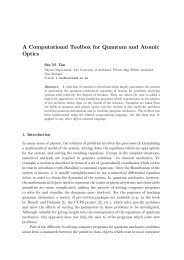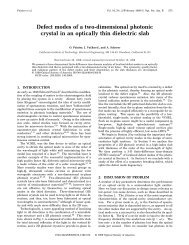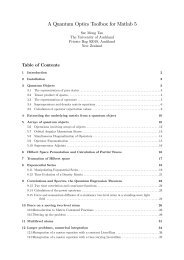Slowing and stopping light using an optomechanical crystal array
Slowing and stopping light using an optomechanical crystal array
Slowing and stopping light using an optomechanical crystal array
Create successful ePaper yourself
Turn your PDF publications into a flip-book with our unique Google optimized e-Paper software.
2<br />
Contents<br />
1. Introduction 2<br />
2. Description of the system: <strong>an</strong> optomech<strong>an</strong>ical <strong>crystal</strong> (OMC) <strong>array</strong> 3<br />
3. <strong>Slowing</strong> <strong><strong>an</strong>d</strong> <strong>stopping</strong> <strong>light</strong> 5<br />
3.1. Static regime . . . . . . . . . . . . . . . . . . . . . . . . . . . . . . . . . . . 5<br />
3.2. Storage of optical pulse . . . . . . . . . . . . . . . . . . . . . . . . . . . . . . 8<br />
3.3. Imperfections in storage . . . . . . . . . . . . . . . . . . . . . . . . . . . . . 9<br />
4. OMC design 10<br />
5. Outlook 13<br />
Acknowledgments 13<br />
Appendix A. Equations of motion for <strong>an</strong> OMC <strong>array</strong> 13<br />
Appendix B. Tr<strong>an</strong>sfer matrix <strong>an</strong>alysis of propagation 15<br />
Appendix C. Optical noise power 16<br />
Appendix D. The b<strong><strong>an</strong>d</strong> structure <strong>an</strong>alysis 17<br />
Appendix E. Implementation in <strong>an</strong> OMC 20<br />
References 24<br />
1. Introduction<br />
Light is a natural c<strong><strong>an</strong>d</strong>idate for tr<strong>an</strong>smitting information across large networks owing to its high<br />
speed <strong><strong>an</strong>d</strong> low propagation losses. A major obstacle to building more adv<strong>an</strong>ced optical networks<br />
is the lack of <strong>an</strong> all-optically controlled device that c<strong>an</strong> robustly delay or store optical wave<br />
packets over a tunable amount of time. In the classical domain, such a device would enable alloptical<br />
buffering <strong><strong>an</strong>d</strong> switching, bypassing the need to convert <strong>an</strong> optical pulse to <strong>an</strong> electronic<br />
signal. In the qu<strong>an</strong>tum realm, such a device could serve as a memory to store the full qu<strong>an</strong>tum<br />
information contained in a <strong>light</strong> pulse until it c<strong>an</strong> be passed to a processing node at some<br />
later time.<br />
A number of schemes to coherently delay <strong><strong>an</strong>d</strong> store optical information are being<br />
actively explored. These r<strong>an</strong>ge from tunable coupled resonator optical waveguide (CROW)<br />
structures [1, 2], where the propagation of <strong>light</strong> is dynamically altered by modulating the<br />
refractive index of the system, to electromagnetically induced tr<strong>an</strong>sparency (EIT) in atomic<br />
media [3, 4], where the optical pulse is reversibly mapped into internal atomic degrees<br />
of freedom. While these schemes have been demonstrated in a number of remarkable<br />
experiments [5]–[8], they remain difficult to implement in a practical setting. Here, we present<br />
a novel approach to store or stop <strong>an</strong> optical pulse propagating through a waveguide, wherein<br />
coupling between the waveguide <strong><strong>an</strong>d</strong> a nearby n<strong>an</strong>omech<strong>an</strong>ical resonator <strong>array</strong> enables one to<br />
map the optical field into long-lived mech<strong>an</strong>ical excitations. This process is completely qu<strong>an</strong>tum<br />
coherent <strong><strong>an</strong>d</strong> allows the delay <strong><strong>an</strong>d</strong> release of pulses to be rapidly <strong><strong>an</strong>d</strong> all-optically tuned. Our<br />
scheme combines m<strong>an</strong>y of the best attributes of previously proposed approaches, in that it<br />
simult<strong>an</strong>eously allows for large b<strong><strong>an</strong>d</strong>widths of operation, on-chip integration, relatively long<br />
delay/storage times <strong><strong>an</strong>d</strong> ease of external control. Beyond <strong>light</strong> storage, this work opens up the<br />
intriguing possibility of a platform for qu<strong>an</strong>tum or classical all-optical information processing<br />
<strong>using</strong> mech<strong>an</strong>ical systems.<br />
New Journal of Physics 13 (2011) 023003 (http://www.njp.org/)






